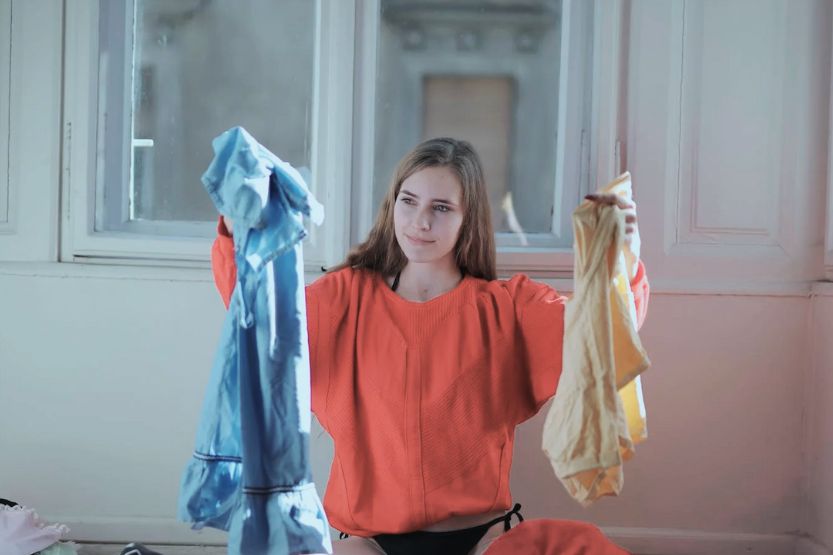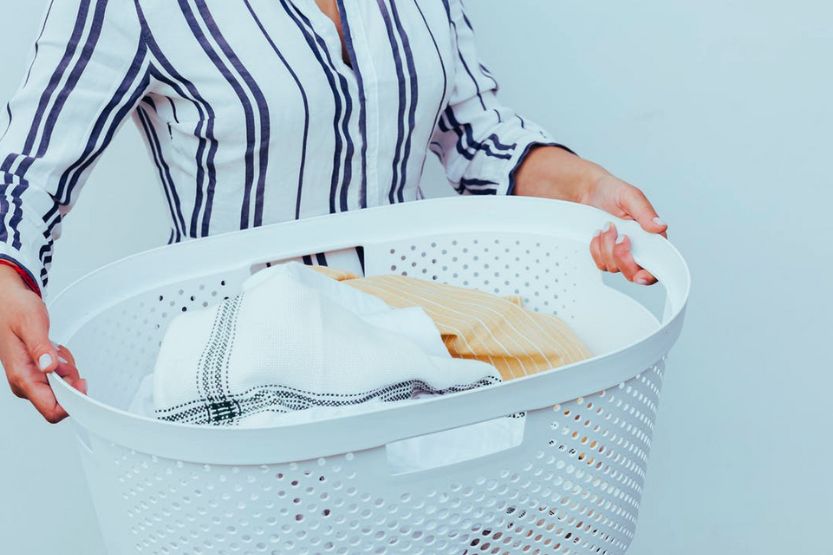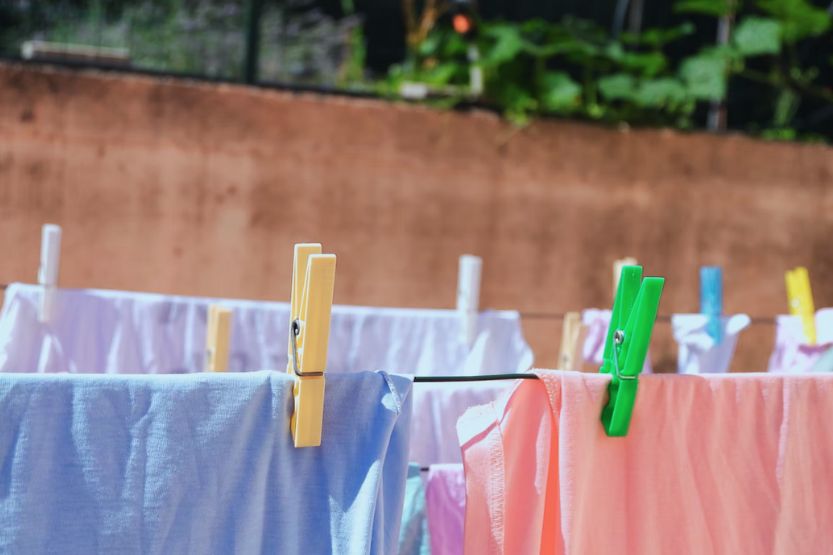Not all people look forward to doing laundry. That’s why finding faster ways to do it is tempting, like drying colored and light clothes together. So, can you dry colored and white clothes together? The quick answer is:
You might think mixing and drying your white and colored clothes is a good idea. It’s not. That’s because of color bleeding or colorfastness (also called fade resistance). Even if your dark-colored clothes are only slightly wet, they can still bleed into white or light-colored fabrics in the dryer—regardless of if you’ve already washed them a few times.
Read on to learn more about drying colored and white-colored fabrics together.
Why Do Colors Bleed in the Dryer?

Do Colors Bleed in the Dryer?
Most of us think that color bleeding happens only during washing. But it’s not unlikely that even slightly damp clothes will transfer dye to light-colored or white clothes in the dryer. As to why that happens, there’s no single explanation.
A mistake most people commit is immediately throwing their clothes in the dryer after they’re washed. As I pointed out earlier, even slightly damp colored fabrics can still bleed color.
Wash the Colored Fabrics in Cold Water
Freshly dyed garments should also sit for at least 20 minutes and undergo several washes before putting them in your dryer. The excess loose dye from the garment could rub off on the inside of your dryer and then transfer to the next batch of clothes you’ll put inside.
So, before putting your laundry in the dryer, wash the excess loose dye in cold water. The cool temperature of the water will trap the dye inside the fabric fibers to prevent further bleeding.
Why Do Other Fabrics Bleed Dye and Others Don’t?
A possible reason is the manufacturer used a dye that’s poor in quality or unsuitable for the fabric they’re working on. Different fabrics require different types of dye. For instance, synthetic dyes are used on cotton, nylon, polyester, silk rayon, and wool.
They’re more likely to bleed than other dyes, although synthetic fibers (e.g., rayon and spandex) hold them better than natural fibers (e.g., cotton and wool).
Using the wrong technique can also make dyes unstable or unable to lock into the fabric. Four of the most popular methods of fabric dyeing are continuous, beck (also known as wench and box dyeing), jet, and jig (also known as jigger dyeing).
The proper technique will usually depend on the fabric and dyes used.
Another possible reason is the manufacturer might’ve forgotten to use a fixative or mordant. Mordants are substances that combine with dye to form an insoluble compound and bind it to the fabric.
Examples of common mordants include the following:
- Cobalt
- Copper
- Iron
- Potassium
- Aluminum sulfate
- Tin
Without mordants or fixatives, fabrics will show poor color fastness, and the dye could bleed in the washer or dryer.
Do All Colored Clothes Bleed?
Not All Colored Fabrics Bleed
Not all colored laundry will bleed into lighter ones. Most fabrics made for quilting don’t usually bleed. However, specific fabric dye colors are more likely to bleed in the washer or dryer. Red and orange clothing are notoriously prone to bleeding, thus requiring you to be more vigilant.
Color Bleeding Has Nothing to Do with a Fabric’s Color
But the truth is this is just a coincidence. The tendency of a fabric to bleed has nothing to do with its color. It just so happens that manufacturers often use direct dye for their red-colored fabrics.
Regardless of its color, this type of dye is more prone to bleed in each wash—unless the fabric has been treated with a cationic fixing agent.
A cationic fixing agent consists of positive-charged molecules. Its positive charge allows it to attach to negative-charged dyes, such as acidic and natural dyes (e.g., indigo blue and Tyrian purple), enhancing the fabric’s color strength and fastness.
It can’t bind with most basic dyes because they have a positive charge.
Check the Fabric’s Label
You don’t need to spend much time guessing which of your colored laundry is more likely to bleed and fade. One of the simplest things you can do is check the product label.
If it says something like “wash before wearing,” “use cold water,” or “color may wash off,” there’s a good chance it’s going to color transfer on your whites and light-colored laundry.
The quality of the fabric may also tell a clue. Most manufacturers will usually not waste money using the best dye on a low-quality fabric. So, before you buy those clothes, look at the label to see the materials that make up the fabric.
Perform a Fabric Bleed Test
Or you could perform a fabric bleed test. Here’s how to do it:
- Dip a small portion of the fabric you want to test in soapy water. The temperature of the water should be similar to the water temperature you usually use during washing.
- Leave the fabric in soapy water for around half an hour before checking for discoloration and bleeding.
- Blot the wet area with a white paper towel if the soapy water is clear. If the white paper towel becomes stained or the test area becomes noticeably lighter, the cloth will most likely bleed during washing or drying.
Again, can you dry whites and colors together? If you don’t want to experience color bleeding or colorfastness, do not dry whites and colors together. Note that even slightly damp colored fabrics can transfer dye to other fabrics.
Does Hot Water Shrink Clothes?
Can You Dry Light and Dark Clothes Together?

You could probably get away with mixing light-colored and dark-colored laundry in the dryer for a little while. But remember that your laundry is still damp after coming out of the washer, so there’s a good chance the dyes found on your dark-colored clothing will bleed and stain your lights and whites.
Sort Your Laundry Before Washing and Drying
To be on the safe side, sort everything before washing and drying. You can sort your laundry into four piles (based on their color):
- Black
- Red
- Dark colors
- White
In that way, you can make sure your clothes stay free of stains and discolorations and keep them in good condition for longer.
Light-colored Fabrics You Can Dry Together
Light-colored fabrics that you can dry together include:
- Pastel shades (e.g., baby blue, pink, and mint green)
- Earth tones (e.g., brown, khaki, and off-whites)
- Other lighter shades of primary colors
Dark-colored Fabrics You Can Dry Together
Dark-colored fabrics that you can dry together include:
- Black
- Dark brown
- Dark green
- Navy blue
- Taupe
- Purple
- Violet
Separate the Laundry Based on Fabric Type
Aside from the color, you can also separate your laundry based on its fabric type. Different types of fabrics need specific care and washing/dryer settings.
For instance, delicate fabrics (e.g., lace, sheer, and silk), woven/knitted fabrics, spandex (elastane), faux leather, and leather should never go in your dryer. Never dry dense fabrics (e.g., jeans) with delicate ones, which can quickly wear out.
Sort Out Old from New Clothes
It’s also important to separate your old clothes from your new ones. New clothes usually bleed easily, especially the first time you wash them. New clothes have residual chemicals, such as formaldehyde, which may leach out and transfer to your old clothes.
Other Tips
Other things to keep in mind:
- Always check the label for special drying instructions.
- Don’t mix laundry with different colors from opposite ends of the color spectrum.
- When drying whites in the dryer, set the temperature to a gentle cycle and low heat (around 125°F). If the temperature is too high, it could leave discoloration of stain or dirt.
- Use the regular cycle when drying light-colored clothes.
- Set your dryer to medium heat (135°F) when drying black and dark-colored clothes to reduce the chance of fading and creases.
How to Prevent Color Bleeding When Using the Dryer
While there are commercial products and techniques for removing dye stains, being proactive is still the best way to prevent fabric dye from bleeding before hitting the dryer.
Below is just a general guide on how to prevent color bleeding in the dryer:
1. Separate the Whites from the Dark-colored and Delicate Laundry
The good news is most of the fabrics made today don’t bleed as much, so there’s a lower chance that your laundry will come out of the washer bright red. Still, it’s essential to keep separating your whites from your dark-color and delicate laundry to be on the safe side.
2. Use Cold Water
Use cold water for your dark-colored and delicate laundry that easily bleeds. Cold water (around 80°F or 26.7°C) will keep the fabric fibers closed. Therefore, the dye stays inside the fibers. Plus, using cold water saves money.
3. Squeeze Out Water from the Laundry
Squeeze out water from your laundry before putting it in your dryer. Soaking wet laundry doesn’t only run the risk of bleeding colors; it might also not get fully dry, causing a musty smell. The excess water could also overwhelm and damage the bearings in your dryer.
4. Try Using Dye-trapping Sheets
If the previous steps aren’t enough, try using dye-trapping sheets, such as Shout Color Catcher. As the name suggests, dye catchers are made up of absorbent fibers that capture loose dye and dirt in your laundry to prevent color bleeding.
Dye catchers are more suitable for dryers but also work well in the washer. They’re not reusable, so if you want to ensure maximum protection for your laundry, use a new sheet every time.
Some use natural ingredients, such as white vinegar, to prevent fabrics from transferring excess dye. If you plan to use them, I highly encourage you to check the care instructions for your clothes first.
What Would Cause an Electric Dryer Not to Heat?
Frequently Asked Questions

Is It Better to Open-air Sun Dry or Machine-dry Your Clothes?
Whether you choose the open-air or machine-drying method, the chances of dye transfer stains happening are almost the same for both drying methods. Therefore, you must still sort your darks and whites and dry them separately.
The best choice is the one that meets your household needs, preferences, and time limitations. But let’s go over some of the advantages and disadvantages of open-air and machine-dry methods to help you avoid unnecessary blunders on your next load of laundry.
Open-Air Drying Method
While this method dries clothes longer, it’s better than a dryer. Some of the significant advantages of hanging your clothes on a clothesline to dry outside include the following:
- It saves money because it doesn’t use electricity
- Clothes are less likely to become damaged or lose their shape
- Better for your health and the environment
- Allows you to put enough space between items to avoid color transferring and save your whites from staining
However, it also has its downsides. For instance, colored laundry could fade over time if they’re constantly exposed to direct sunlight. Fortunately, the solution is simple: hang your delicate and colored laundry out of the sun so they don’t fade.
Machine-Drying Method
Experts discourage people from air-drying their clothes inside their homes, especially if it’s poorly ventilated. This creates the best environment for mold spores to grow, which could negatively affect your health.
So, if you live in a poorly ventilated home or somewhere that doesn’t get enough sunlight, you should use the dryer.
Depending on the outside temperature, fabric type, and presence (or absence) of wind, most fabrics usually take around two to four hours to air-dry. With drying machines, you don’t need to wait that long.
Plus, they eliminate the need to iron your clothes because the heat they produce often removes wrinkles from the fabric.
Can You Dry Striped Clothes with White and Dark Clothes?
If you want to save yourself the guesswork, use color catchers. These dye-trapping sheets let you launder your striped clothes with whites, lights, and darks.
But if you don’t have them, the answer to the question is, it depends. There are specific rules you need to follow. For instance, you can dry dark-colored clothes with stripes if they’re not new and have already been washed a few times.
But, you wouldn’t want to dry your stripes with red clothes because they’re notorious for ruining whites and light-colored garments.
Conclusion – Can You Dry Whites and Colors Together?
Drying whites and colors together can be a nerve-racking and tedious task. However, drying your clothes correctly is essential to lengthen their lifespan and prevent them from getting damaged.
There’s no other way to make sure you separate your clothes into different piles (whites, light colors, dark colors, reds, and blacks) before putting them in the dryer or line drying them.
But if ever you’re unsure about how to dry colored clothes and white clothes, read the care instructions on their label.
Read next:


![Read more about the article What Is a Lanai, Lanai Porch, Lanai Patio? [With Pictures]](https://homecarezen.com/wp-content/uploads/2020/05/what-is-a-lanai-150x150-1-300x200.jpg)

